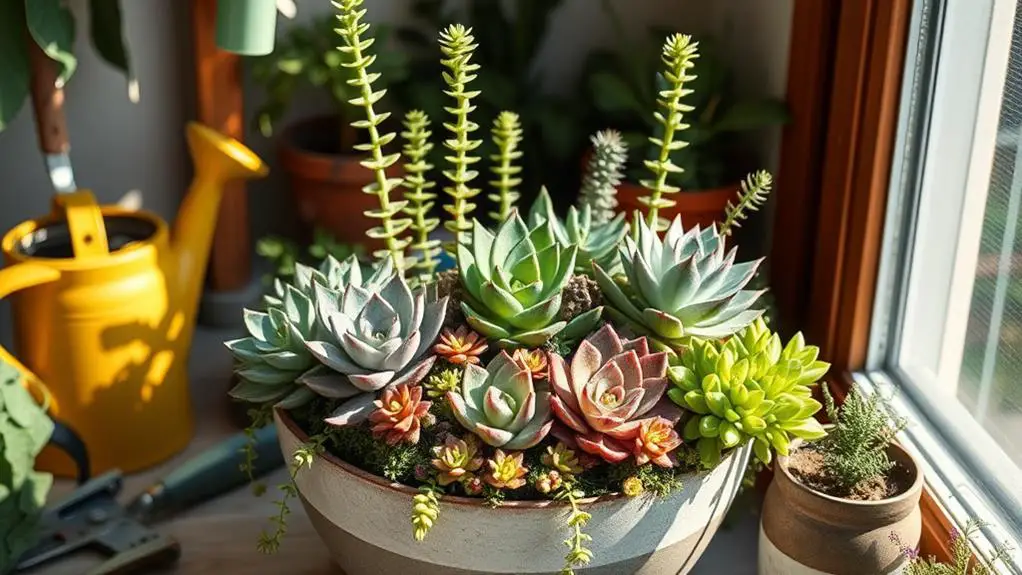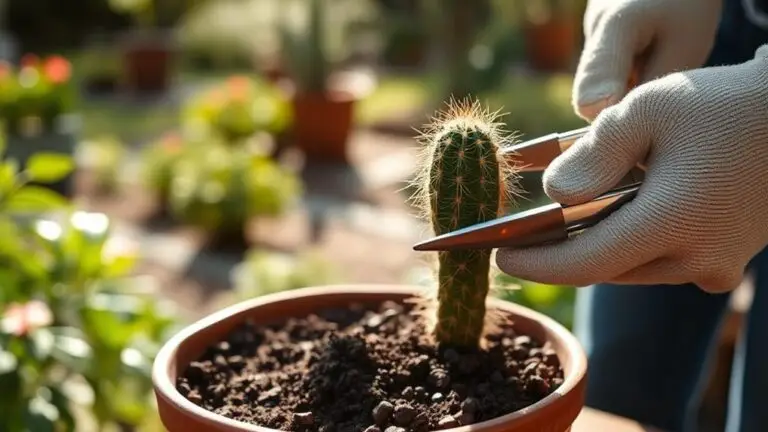7 Essential Tips to Care for Your Succulent Arrangement
Caring for a succulent arrangement isn't as simple as it might seem, but with the right approach, you can guarantee your plants thrive. You'll need to master techniques like the "soak and dry" method for watering and understand the importance of rotating your plants to provide even light exposure. Cleaning, pruning, and monitoring for pests are also essential tasks to keep your arrangement healthy. But what about choosing the right plants to grow together or the best practices for propagation? These tips will help you maintain a vibrant and thriving succulent collection.
Watering Techniques
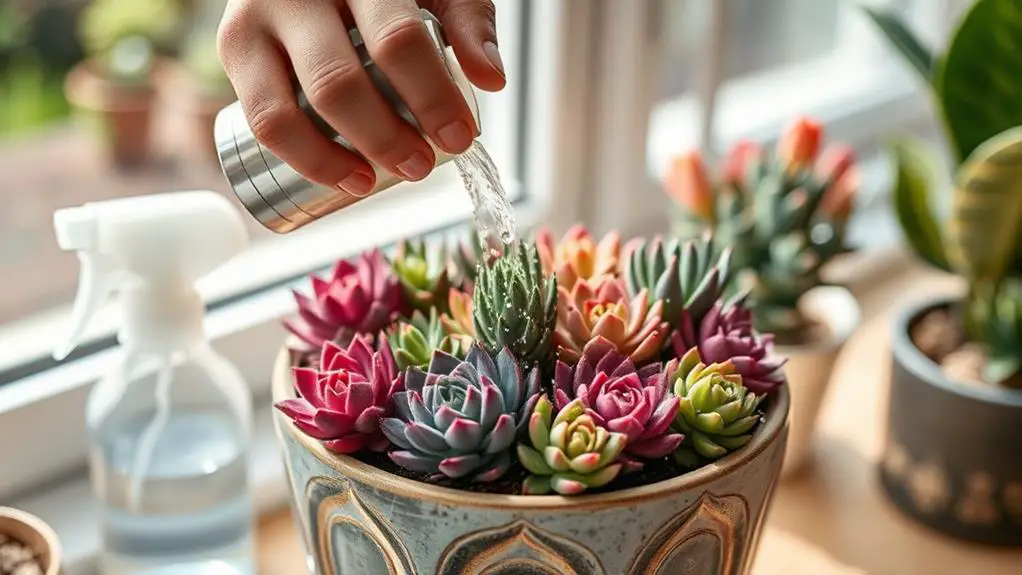
When it comes to watering succulent arrangements, timing and technique are everything. To keep your succulents healthy, you need to water them only when the top 1.25 inches of soil feels dry. This guarantees they get the moisture they need without being overwatered.
One effective method is called "soak and dry." It means thoroughly soaking the soil until water drains out of the drainage holes, then letting it dry completely before the next watering.
Another helpful technique is bottom-watering. Simply place your succulents in a shallow dish of water for 5-15 minutes. This allows the plants to absorb moisture through their drainage holes. Always use room temperature water to avoid shocking them. Adjust your watering schedule based on the seasons and your home's environment.
It's important to avoid wetting the foliage when you water your succulents. Getting water on the leaves can lead to rot and disease. Instead, focus on saturating the soil.
Light Exposure
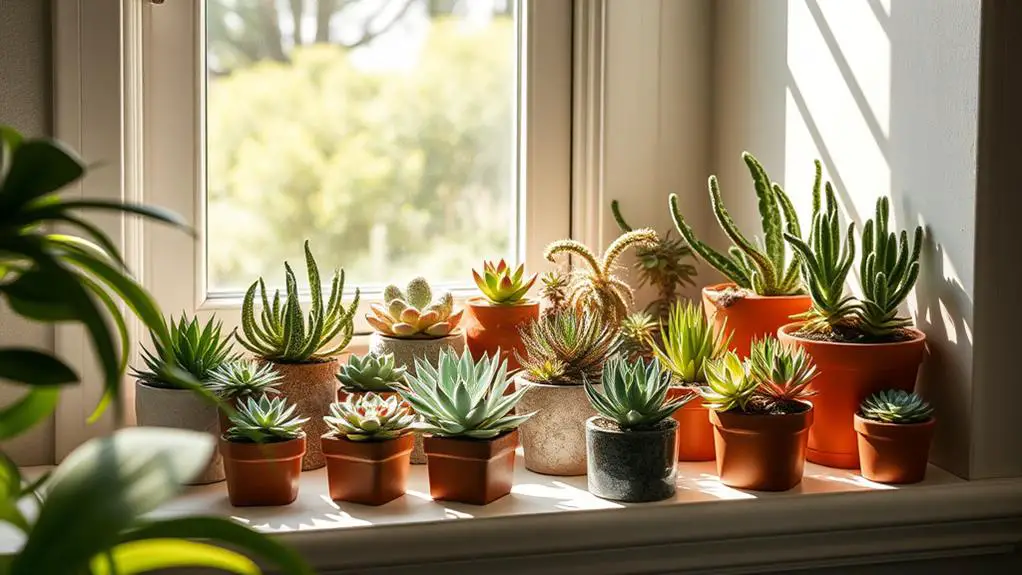
To keep your succulents healthy and colorful, make sure they get around 6-8 hours of bright indirect sunlight each day.
If possible, give them 4 hours of direct morning sunlight to boost their growth.
To prevent issues like leggy growth and color loss, rotate your arrangements weekly and consider using sheer curtains for sensitive varieties.
Optimal Daily Sunlight
Getting the right amount of sunlight is essential for keeping your succulent arrangements healthy and vibrant. Succulents love light and need about 6-8 hours of bright indirect sunlight daily. This helps them maintain their vibrant colors and thrive. A great care tip is to allow your succulents to get 4 hours of direct morning sunlight. This full sun exposure promotes healthy growth without risking sunburn.
To avoid uneven growth and guarantee all parts of your succulent arrangement receive equal light, rotate the pots weekly. This simple action prevents your plants from leaning towards the light source and keeps them looking balanced.
Here's a handy table to summarize the light needs for your succulents:
| Light Type | Recommended Hours | Benefits | Care Tips |
|---|---|---|---|
| Bright Indirect Sunlight | 6-8 hours | Maintains vibrant colors | Place near windows with indirect light |
| Direct Morning Sunlight | 4 hours | Promotes healthy growth | Ideal for morning exposure, avoid midday sun |
| Insufficient Light | Avoid | Prevents leggy growth | Guarantee daily light exposure |
| Rotating Arrangement | Weekly | Ensures even growth | Rotate pots to balance light distribution |
Using sheer curtains can provide necessary shade without blocking the light. This protects succulents from excessive direct sunlight while still allowing them to get the light they need.
Preventing Light-Related Issues
Ensuring your succulents receive the right amount of light is essential for their health and appearance. Succulents thrive with 6-8 hours of bright indirect sunlight daily. Many varieties also benefit from 4 hours of direct morning light.
If your succulent arrangements aren't getting enough light, you may notice the plants stretching and losing their vibrant colors. This indicates that they need more exposure.
To prevent light-related issues, keep these tips in mind:
- Rotate weekly: Turn your succulent arrangements weekly to promote even growth and prevent them from leaning towards the light source.
- Watch for sunburn: Look for signs of sunburn, such as beige or brown patches on leaves. These can result from too much direct sunlight, so adjust their location if needed.
- Use sheer curtains: Consider using sheer curtains to filter intense sunlight. This provides necessary shade without completely blocking the light your succulents need.
Cleaning and Maintenance

When it comes to keeping your succulent arrangements looking their best, regular cleaning and maintenance are crucial. Start by checking for dust and dead leaves, as these can hinder growth and reduce vigor. Use a damp cloth to gently wipe the foliage, but be careful not to wet the leaves too much, as this can lead to rot.
Next, clear out any weeds that might've sprouted. You can pull them out by hand or add a layer of rocks or pebbles to the soil's surface, which helps keep the arrangement tidy and prevents weeds from taking hold.
Inspect your succulent arrangement regularly for any signs of pests or disease. If you spot anything unusual, address it quickly to keep your plants healthy.
Maintaining a consistent cleaning routine is key. Not only does it support healthy growth, but it also guarantees your succulents look vibrant and beautiful.
Regular maintenance doesn't have to be complicated. By following these simple steps, you'll keep your succulent arrangements thriving and attractive.
Keep up with your cleaning routine, and your plants will reward you with their stunning appearance and robust health.
Pruning Practices
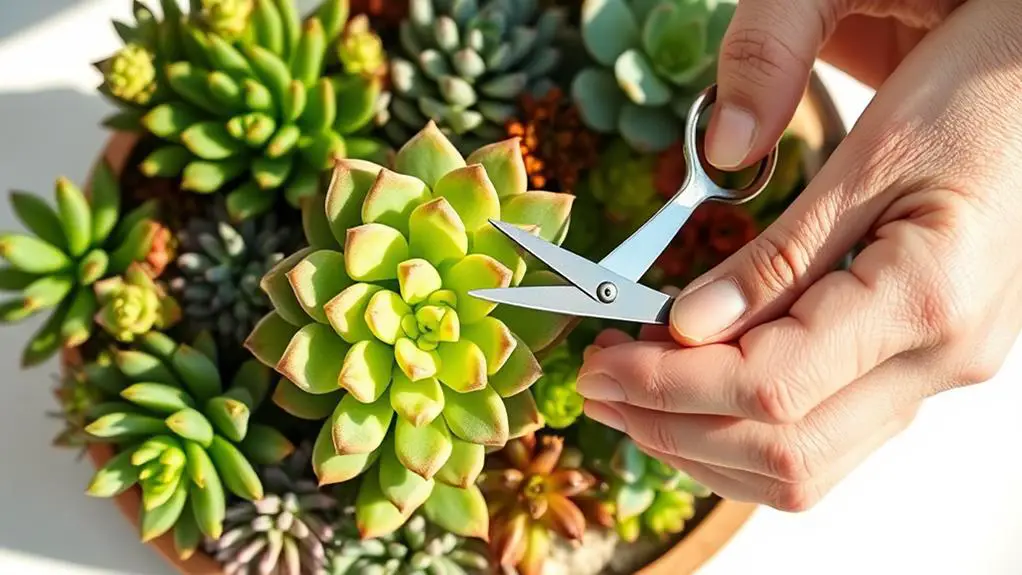
After guaranteeing your succulent arrangements are clean and well-maintained, it's time to focus on effective pruning practices. Pruning your succulents is essential to keep them healthy and promote new growth. Start by pruning at the beginning of the growing season for the best results. This helps rejuvenate your arrangement and guarantees your succulents thrive.
Always use clean, sterilized pruning tools to prevent the spread of diseases. Carefully remove any stretched or overcrowded succulents by cutting off their tops. This improves air circulation and light exposure, ensuring each plant gets what it needs to grow well.
Remember to allow the cuttings to callus for a few days before replanting them. This step is vital to prevent rot and guarantees successful propagation.
Regularly eliminate dead or dying succulents to prevent decay and the spread of disease.
Here are some key tips to keep in mind:
- Use clean, sterilized tools to avoid spreading disease.
- Allow cuttings to callus before replanting to prevent rot.
- Remove overcrowded plants to improve air circulation.
Plant Compatibility
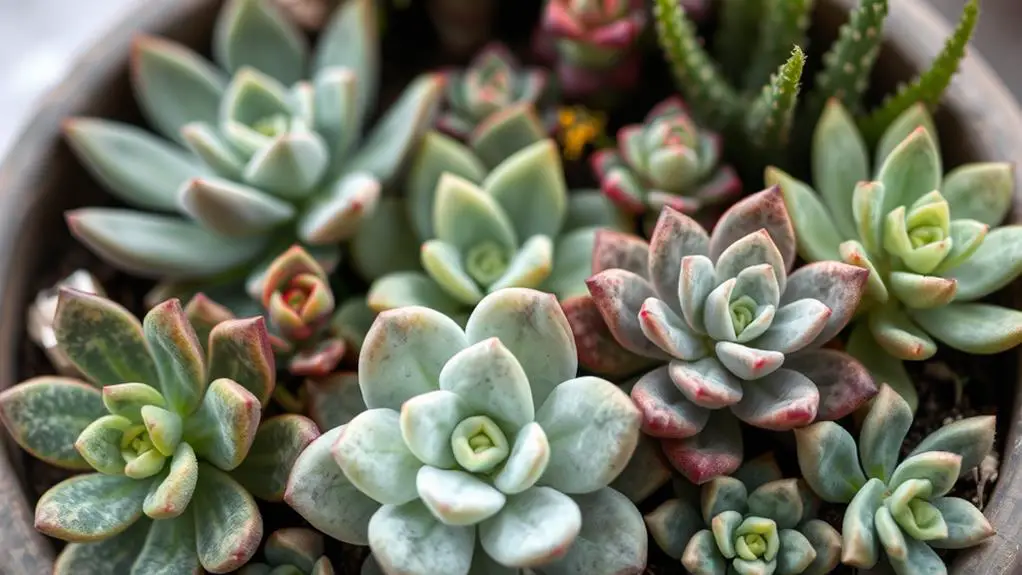
Creating a harmonious succulent arrangement starts with understanding plant compatibility. First, research the watering needs of different succulent varieties. Grouping plants with similar water requirements promotes healthy growth and reduces stress. Confirm that your soil mix and drainage system can support these needs effectively.
Consider the growth rates of the succulents you want to arrange together. Pairing fast-growing varieties with slow-growing ones can lead to overcrowding and competition for resources. It's better to choose plants that grow at similar rates for a balanced arrangement.
Assess the light and temperature requirements of each succulent species. Some succulents thrive in bright light, while others prefer indirect sunlight. Matching these needs will help prevent stress or damage.
Similarly, succulents should be placed in environments where the temperature suits all the varieties in your arrangement.
Avoid mixing succulents with notably different care needs. If one plant requires more moisture and another prefers dryness, it can lead to health issues.
Regularly monitor your arrangement for signs of stress, like leggy growth or discoloration, and make adjustments as needed. By paying attention to these factors, you'll create a thriving and beautiful succulent arrangement.
Pest Management
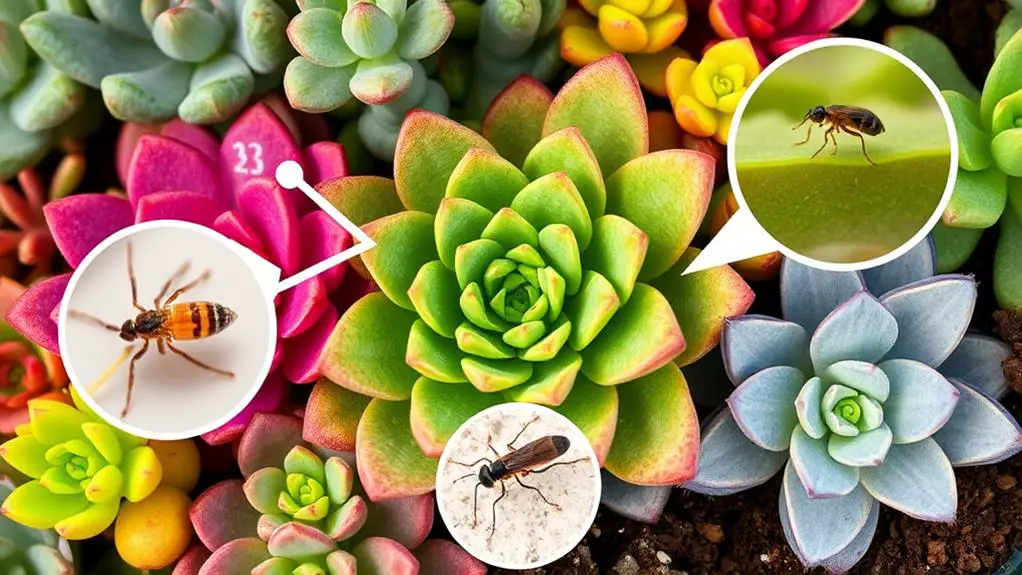
While plant compatibility sets the foundation for a thriving succulent arrangement, maintaining its health requires proactive pest management. Regularly inspect your succulents for pests like mealybugs, aphids, and thrips. Early detection is essential to prevent full-blown pest infestations. If you spot any, act fast. Treat minor pest infestations using a diluted solution of 70% rubbing alcohol or insecticidal soap. Spray directly on the affected areas for effective control.
Good air circulation is key to reducing the risk of pests and mold. High humidity can encourage these issues, so guarantee your plants have space to breathe. Isolate any infested plants immediately to prevent pests from spreading to the healthy ones. This step is necessary for containing the problem and treating it separately.
Maintaining cleanliness in your growing area is another critical aspect. Remove dead leaves and debris regularly. This not only minimizes pest attractions but also promotes overall plant health.
Here's a quick checklist to help you manage pests:
- Inspect regularly: Look for signs of pests like mealybugs, aphids, and thrips.
- Treat immediately: Use diluted rubbing alcohol or insecticidal soap for minor infestations.
- Maintain cleanliness: Remove dead leaves and debris to discourage pests.
Propagation Methods
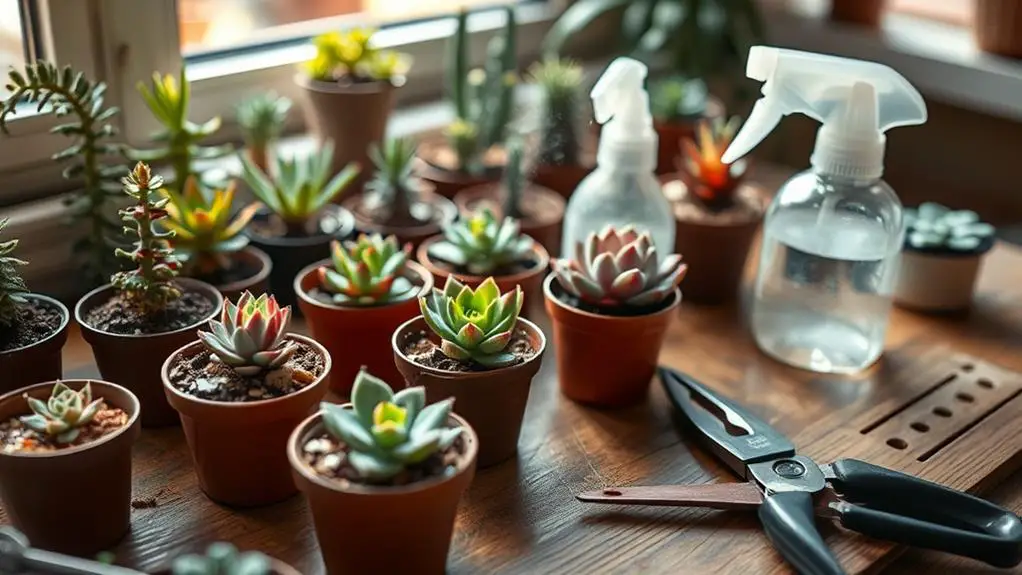
Successful propagation of succulents can be a rewarding and straightforward process. To get started, use either leaf or stem cuttings from your existing plants. Allow the cut ends to callous for a few days before planting them in well-draining soil. This step is essential because it helps prevent rot.
Once planted, keep the soil slightly moist until roots develop. This usually takes about 2-4 weeks. During this time, place your cuttings in bright, indirect sunlight. Too much direct sunlight can be harsh, but a sunny window or a well-lit room works great.
Monitor your cuttings for new growth. This is a sign that your propagation methods are working. Once you see new growth, gradually acclimate the new plants to normal care conditions. Remember, waterlogged soil can harm your succulents, so guarantee good drainage.
For better success rates, consider using a propagation station or container that allows for adequate airflow around the cuttings. Certain succulent varieties, like Echeverias and Sedums, are especially well-suited for propagation. They're a great choice if you're just starting out.
With these tips, you'll find propagating succulents both enjoyable and successful. Happy gardening!
Frequently Asked Questions
How to Maintain a Succulent Arrangement?
To maintain your succulent arrangement, check soil moisture, water when dry, provide 6-8 hours of indirect sunlight, clean the foliage, prune dead leaves, and monitor for pests. These steps guarantee your succulents stay healthy and vibrant.
How Do You Arrange Succulents Together?
To arrange succulents, group varieties with similar watering and light needs. Consider their growth rates to prevent overcrowding. Use well-draining pots and inspect regularly for dead leaves or stress. This guarantees a healthy, thriving arrangement.
How Often Do You Water a Succulent Arrangement?
You should water your succulent arrangement only when the top 1.25 inches of soil is dry. Typically, this means weekly in summer, bi-monthly in spring and fall, and less often in winter. Adjust for environmental factors.
How Do You Take Care of a Succulent Combo?
To take care of a succulent combo, choose varieties with similar water needs, provide 6-8 hours of indirect sunlight, use well-draining soil, monitor for stress, prune dead parts, and repot every 1-2 years.
Conclusion
Taking care of your succulent arrangement isn't hard if you follow these tips. Water when the soil is dry, give them plenty of light, and keep them clean. Remember to prune at the start of the growing season and watch for pests. Also, make sure they have good drainage. With these steps, your succulents will thrive. You've got this, and your plants will thank you with their healthy, vibrant growth!

